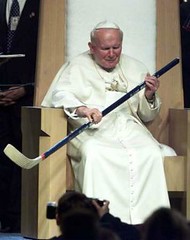
Joe Kainz
Karol Wojtyla: A Model of Faith

One may think they have never heard of this man, or what he did, but what if I said his more common name: Pope John Paul II. This son of an army officer and schoolteacher would one day become the successor to St. Peter and leader of over one billion Catholics worldwide, but his journey was one with many struggles, requiring much faith in God and himself.
Karol Jozef Wojtyla was born on May 18, 1920 in Wadowice, Poland, a small town just south of Krakow. Tragedy had a tendency to strike Wojtyla as a young child. His infant sister died at birth, his mother died of heart and kidney troubles when he was nine years old, and his only other sibling died of scarlet fever when Wojteyla was twelve. Tragedy seemed to come after Wojtyla personally. As a college student, he was hit by a streetcar and a truck. The fact that Karol Wojtyla was able to overcome all of these is just a testament to the kind of faith that he had.
In 1938, Karol Wojtyla and his father moved to Krakow so that Karol could take classes at Jagellonian University, where he followed his passions and studied literature and philosophy. However, in 1940, the Germans occupied Poland, during which Wojtyla put his studies on hold and took a job as a stonecutter in a quarry. As if there were not enough suffering in his life already, in 1941, Karol Wojtyla’s father died, whose dream was to see his son be ordained a priest.
Wojtyla carried out his studies at an underground seminary, and when the Nazis began rounding up men, he found safety in the house of the archbishop of Krakow. In 1946, Karol fulfilled his fathers dream by being ordained a priest, finished up his studies, and started his ministry at as an assistant pastor. Wojtyla quickly rose through the ranks of the church. On July 4, 1958, Pope Pius XII named Karol an auxiliary bishop in the archdiocese of Krakow. Five years later Pope Paul VI appointed Karol Wojtyla as the archbishop of Krakow. Wojtyla really started to be noticed throughout the Church world for his intellectual contributions to the Second Vatican Council. There he stressed religious freedom, and gained so much respect around his peers, that in 1967 he was named a cardinal.

When the cardinals met in October of 1978, Wojtyla had become well-known and widely respected. When the council had not been able to agree on the traditional Italian candidate, Karol’s name started to be thrown around as the next pope. The council agreed, and on the eighth ballot, 103 of the 109 votes were for Cardinal Karol Wojtyla, who took the name Pope John Paul II. Pope John Paul II was the first non-Italian pope to be elected in 456 years. On top of this, he was only fifty-eight years old at the time, considered a young age for a pope.
In addition to standing up against Communism, being named Man of the Year in 1994 by Time magazine, and visiting 115 countries, perhaps John Paul II’s most evident example of faith came in 1981. While riding through St. Peter’s Square in his jeep nicknamed the “Popemobile”, a Turkish man named Mehmet Ali Agca shot the Bishop of Rome, which required a major surgery in order for the pope to recover. Four days later, however, Pope John Paul II did the unthinkable; he publicly forgave Agca and went to speak with him in prison.
Model of Faith
Karol Wojtyla should serve as an example to all people to what real faith is. He was able to overcome the deaths’ of many of his family members. He had faith that God would get him through the troubled times of the Nazi occupation in Poland. He had faith in the true good of people, when he forgave the many who nearly killed him. Finally, he had enough faith to convince over a billion other people that what he believed in was worth believing. He is the epidomy of a person who has great faith.
Sources